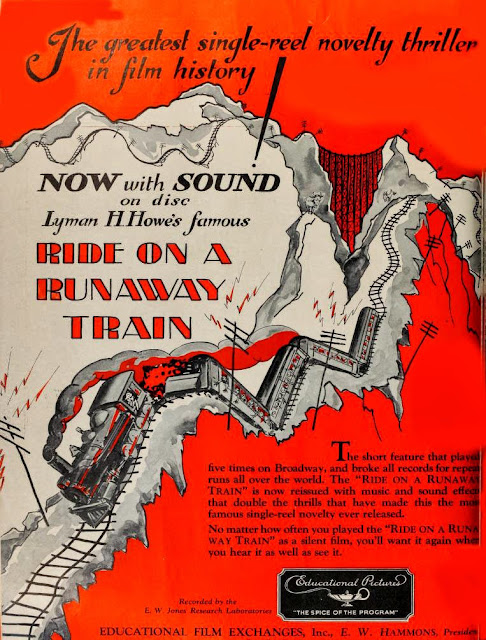Greenbriar Still Aboard The Train
I'm really drunk on this runaway train, enough so to delve further into its progress through theatres and homes during 20's peak of popularity. What motivates the search, of course, is having been blown away by restoration of Lyman H. Howe's Famous Ride on a Runaway Train as six-minute highlight of the National Film Preservation Foundation's DVD release from a well-publicized
Despite horn of plenty, the Runaway Train stood out, so much so that Capitol management repeated it a month later, this time backing more live bits from Pagliacci, further ballet dosage, Harold Lloyd's "first three-reeler" Now Or Never, and Will Rogers in Boys Will Be Boys. The Capitol's overture tendered selections from Faust. Here was footloose mélange of high and low culture, not at all untypical of palace entertainment that sought to please everyone filling the Capitol's 4,000 seats. The hit Howe's train ride made led to Educational Film Exchange, Inc. buying distribution rights in June 1921, barely a month after the Capitol splash. What clicked in
 |
| Among 16mm Offerings To Home Collectors For March 1928 is Howe's On A Runaway Train |
 |
| A Tilted Subjective Camera Spikes The Thrill of a Train Run Amok |
 |
| Educational's Revamped Ride with Sound, Released 6/15/29 |
Thanks to the splendid resource that is LANTERN and ongoing enrichment of film history by David Pierce and Eric Hoyt. Also thanks to Scott MacGillivray for sharing of Educational's Lyman H. Howe Hodge-Podge trade ad.






3 Comments:
That editing machine in the ad is pretty similar to the one I had for my 8mm camera eons ago.
Dan Mercer contemplates what early film could do toward manipulating reality ...
There seems to be a progression from the first demonstrations by the Lumiere brothers of the cinema, to Lyman H. Howe's cinematic adventure, and finally to "This is Cinerama" or even the early IMAX films. At each step, the unique qualities of the cinema triggered a visceral reaction in the audience. The ones who saw the film of a train entering a station were thrilled and frightened, because their understanding was such that an image of a train could not exist unless a train actually was approaching them closely, and in that very theater. In time, however, such experiences allowed them to differentiate between the world of reality as they knew it to be and the appearance of reality on film, which in itself became an aspect of that reality. Thus, to repeat the thrill of the initial experience, it had to become more and more vivid--more life-like--so that there was for a moment no separation between film and commonplace reality. Lyman H. Howe's film was more enveloping than that of the Lumieres, so that his audiences were less able to disassociate themselves from what they were experiencing in the theater, or at least, better able to suspend an appreciation of that difference as they had already come to understand. "This is Cinerama" carried the process much further, surrounding the audience with an image in full color and with directional sound, again in an attempt to obliviate the distinction between film and reality. The term "obliviate" is deliberate. It means to forget. What Lyman H. Howe sought or any of the others was a kind of forgetfulness, and what was achieved, if only for that moment, was a state of being or awareness resulting from that lack of remembering. We've come to understand it ourselves in any number of ways growing up, even from our first acquaintance with film or love. Nothing will ever be for us as it was, for the first time. But if we remember how it was--if we do not forget--some residue of that sense of wonder remains, and we know ourselves, at least, just a little better for that.
Daniel
What surprises me is that Educational didn't make this reissue a talking picture. It would have been easy to add narration for realistic dialogue effects ("All aboard," etc.) without the bother of lip-synching. Imagine the you-are-there effect of an offscreen announcer exclaiming, "Hold on to your seats... the train is running away!"
I guess the title cards stayed in for the benefit of those theaters that hadn't yet wired for sound, so Educational could release it both ways.
Post a Comment
<< Home